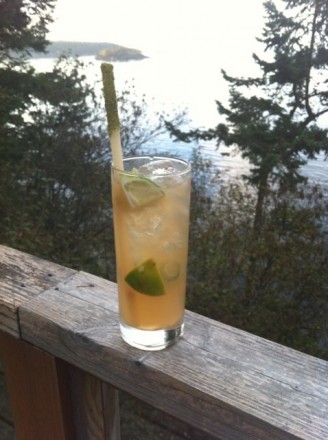Somewhere among the notebooks of Gideon I once found a list of diseases as yet unclassified by medical science, and among these there occurred the word Islomania, which was described as a rare but by no means unknown affliction of spirit. There are people, as Gideon used to say, by way of explanation, who find islands somehow irresistible. The mere knowledge that they are on an island, a little world surrounded by the sea, fills them with an indescribable intoxication….But like all Gideon’s theories it was an ingenious one. I recall how it was debated by candlelight in the Villa Cleobolus until the moon went down on the debate, and Gideon’s contentions were muffed in his yawns; until Hoyle began to tap his spectacles upon his thumbnail of his left hand, which was his way of starting to say goodnight….Yet the word stuck; and though Hoyle refused its application to any but Aegean islands….we all of us, by tacit admission, knew ourselves to be ‘islomanes.’
Five years ago today, I steered an overfull Land Rover north in the early morning mist to catch the ferry in Anacortes and take possession of my house on San Juan Island. My belongings would largely follow a month later, after small renovations and frenzied trips south to pack and prepare for the moving truck. But the first weeks as an islander were magical. The house was empty apart from evidence of construction and small enclaves of domesticity — a futon, a card table, and some deck furniture. I virtually lived on the deck for weeks, in shorts, in warm weather that now seems a fond memory.
As I have written in years past on this day, my island home matures from innocent idyll to complex daily reality, and my fondness for it changes as well, acquiring both depth and sharp edges, as I negotiate a middle ground between deep involvement and the fondly remembered invisibility and anonymity of my first days. Coming, as I do, from urban America, I find that in order to live in my woodsy enclave on the quiet, almost people-free, waters of Rocky Bay and the Waldron-Orcas-SJI confluence, I have signed up to live in a classic “small town,” for better or worse.
In my annual paean to island life, on the anniversary of my northward migration, I quote Lawrence Durrell’s book, “Reflections on a Marine Venus,” which I reread each year as this date approaches. This year, I read it, but I find that I no longer associate it with my island home. This is a sad thing, since my islomania continues unabated, and I fully agree with the sentiments Durrell expresses.
But the tone of Durrell’s islomania, expressed in the language of the early 20th century educated British expatriate, is no longer my tone. Durrell speaks as a visitor, fundamentally. He speaks as one coming from a foreign culture, enjoying his contact with the new and the different. He speaks as one kind of islander, visiting another kind of islander.
As I sit here on the deck tonight, listening to the music playlist that accompanied my trip on the ferry and landing in Friday Harbor, and after re-reading the first pages of Durrell’s book — paragraphs that virtually defined my journey north — I find myself writing a very different “annual report” than usual. I sat down thinking that I would give the usual “trip report.”
Instead, I find myself eulogizing, and drawing to a close, the words and metaphors which defined that journey. The motivations and events which led me here are in the past. I am deeply involved in my community, sometimes more than I have time for or would like. But that involvement disallows the perspective of the expatriate, the viewpoint of one who loves a place, but will soon move onward. Durrell’s words will continue to have deep meaning for me, but it’s time to retarget them outward, to places I hope to visit and enjoy.
For the island, five years on, is nothing more or less than….home. With all of the pleasure, comfort, frustrations, and occasional pain that this denotes.
 Mixology Monday this month, brought to us by
Mixology Monday this month, brought to us by 
